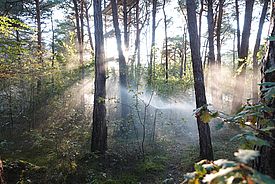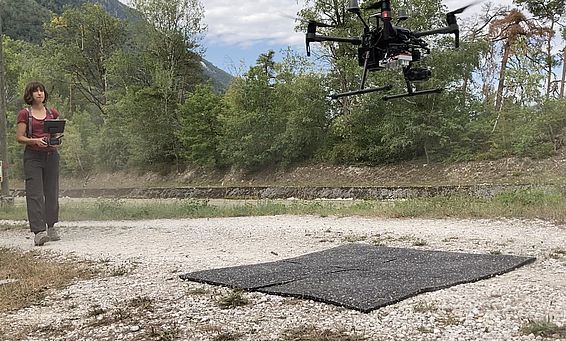22.9.2021 | Gottardo Pestalozzi | News WSL
All us nature lovers can tell if a tree is in poor health by the discoloration or loss of leaves. At this point, deterioration is already at an advanced stage, possibly showing irreversible damage. In a new study, researchers from the Swiss Federal Institute for Forest, Snow and Landscape Research WSL show how tree stress can be detected before it becomes visible to the eye, extracting information from spectral data collected using drones.
Detecting tree stress early is important for understanding the increasing effects of drought on forests as well as identifying tree species that can cope well with drought. Thus, researchers have long been searching for ways to measure tree response to environmental changes. Researchers rely on different techniques to measure tree stress responses. Analyzing tree rings for example can show a slowdown in tree growth over several years. Another way is to measure the decline in photosynthesis during a heat wave. These approaches are valuable but very time consuming because researchers must engage with each tree individually. Thus, only a few trees can be monitored in a forest.
Drone-borne photographs with multispectral camera ¶
A new study by the Swiss Federal Institute for Forest, Snow and Landscape Research (WSL) now shows that the stress level of every tree in a forest can be detected from the air using a multispectral camera. During a series of experiments, lead author Petra D'Odorico and fellow researchers conducted drone flights over pine trees in the Pfynwald Forest (Valais). She explains, "In simplified terms, we can say that the sunlight reflected from the tree crowns contains information on the physiology of the trees and thus on the current tree condition." Her experiments have shown that the reflected light reveals changes in photosynthetic pigments (chlorophyll and carotenoid). By analyzing these pigments changes, it is possible to deduce how much the tree is investing in photosynthesis, and therefore growth, or in other processes that become necessary when resource availability is unfavorably distributed.
Drought is expected to become the most common cause of tree mortality in the coming decades. Just when the least water is available, the light irradiation is often the strongest. As a result, the leaves or needles find themselves in an unbalanced condition: they absorb more energy than they need for photosynthesis, as stomata close to prevent desiccation. To dissipate the potentially detrimental excess energy, needles crank up the conversion of pigments. This activity can be observed by collecting multispectral imaging data, a technique that makes information invisible to the human eye detectable. “Through this method it is as if we can see the invisible stress building up in a tree”, D’Odorico explains, “we can tell if trees that still appear healthy are already suffering from drought stress”.
The drone measurements took place during the 2019 and 2020 growing seasons in the Pfynwald Forest, where WSL is conducting a unique long-term experiment. At this site in Valais, one of the driest inner-alpine valleys in Europe, pine trees (Pinus sylvestris) have been exposed to different irrigation treatments since 2003. In addition to detecting stress responses to drought, the new study also found that tree history and thus the environmental conditions of the past, influence the current tree response to stress.
Remote observations with drones allow many more trees to be measured in a short time than with classical physiological contact measurements from the ground. While to date this method cannot be used operationally for forest management, it will be indispensable in the future as a complement to other techniques to predict forest response to warmer and drier conditions.
The authors would like to take this opportunity to thank the Burgergemeinde Leuk, the local forestry service, and the company for electricity and hydropower FMV for their great collaboration over many years. This work was supported by the Swiss National Science Foundation (SNSF) through a Spark funding scheme for innovative research grant to Petra D'Odorico.
Drone-based physiological index reveals long-term acclimation and drought stress responses in trees
Contact ¶
Links ¶
Copyright ¶
WSL and SLF provide the artwork for imaging of press articles relating to this media release for free. Transferring and saving the images in image databases and saving of images by third parties is not allowed.


